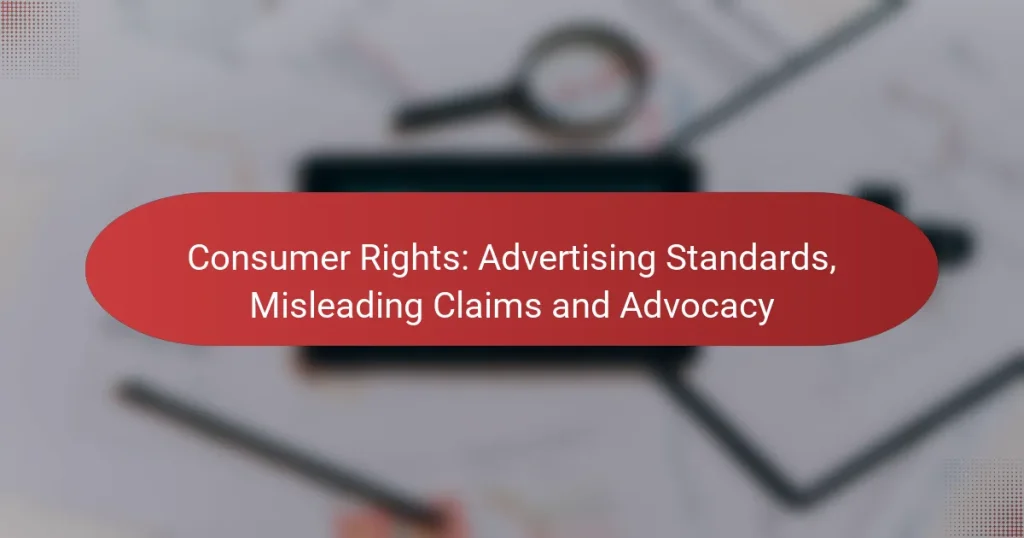Truth in advertising is a fundamental aspect of consumer rights, ensuring that individuals receive accurate and honest information about products and services. In South Africa, these rights protect consumers from misleading claims and unfair treatment, allowing them to report false advertising to relevant authorities. Regulatory bodies enforce penalties for violations, promoting fair advertising practices and safeguarding consumer interests.
Reporting Misleading Advertising: Steps, Resources and Support
Consumer Feedback: Impact on Advertising Practices and Standards
Educating Consumers: Recognizing False Claims and Resources
Advertising Regulations: Resources, Understanding and Compliance
Consumer Rights: Advertising Standards, Misleading Claims and Advocacy
What are consumer rights in advertising in South Africa?
In South Africa, consumer rights in advertising ensure that consumers receive accurate and honest information about products and services. These rights protect individuals from misleading claims and unfair treatment in the marketplace.
Right to truthful information
The right to truthful information mandates that all advertising must be clear, accurate, and not misleading. Advertisers are required to provide essential details about products, including price, features, and any potential risks.
For instance, if a product claims to be “100% natural,” it must genuinely meet that standard without hidden additives. Consumers should be able to trust that the information presented in advertisements reflects the actual characteristics of the product.
Right to fair treatment
The right to fair treatment ensures that consumers are not subjected to unfair practices or discrimination in advertising. This includes the prohibition of aggressive marketing tactics that exploit vulnerable groups.
For example, advertisements should not target children with misleading claims about toys or snacks. Fair treatment also involves providing equal access to products and services without bias based on race, gender, or socioeconomic status.
Right to privacy
The right to privacy protects consumers from invasive marketing practices that compromise their personal information. Advertisers must obtain consent before collecting or using personal data for marketing purposes.
Consumers should be informed about how their data will be used and have the option to opt-out of targeted advertising. This right is crucial in maintaining trust between consumers and businesses in an increasingly digital marketplace.
How can consumers report false advertising?
Consumers can report false advertising by contacting relevant authorities that oversee advertising practices. This process typically involves submitting a formal complaint detailing the misleading advertisement and its impact on consumers.
Contact the Advertising Standards Authority of South Africa
The Advertising Standards Authority of South Africa (ASA) allows consumers to report misleading advertisements directly. To file a complaint, you can visit their website and complete the online complaint form, providing details about the advertisement and why it is considered false.
Complaints to the ASA are usually resolved within a few weeks, and they may issue rulings that require the advertiser to amend or withdraw the misleading content. It’s important to keep records of the advertisement and any correspondence related to your complaint.
File a complaint with the National Consumer Commission
The National Consumer Commission (NCC) is another avenue for consumers to report false advertising in South Africa. Complaints can be submitted through their online platform or by contacting their offices directly. Ensure you include all relevant information, such as the nature of the advertisement and how it misled consumers.
The NCC investigates complaints and can take action against businesses that violate consumer rights. They may impose penalties or require corrective measures, making it essential for consumers to voice their concerns about misleading advertising practices.
What are the penalties for false advertising in South Africa?
In South Africa, penalties for false advertising can include fines and legal actions against the offending party. Regulatory bodies enforce these penalties to protect consumers from misleading claims and ensure fair advertising practices.
Fines imposed by regulatory bodies
Regulatory bodies such as the Advertising Standards Authority of South Africa (ASA) can impose fines on companies that engage in false advertising. These fines can vary widely, often ranging from thousands to millions of rand, depending on the severity of the violation and the company’s revenue.
In addition to financial penalties, companies may be required to retract misleading advertisements and issue corrective statements. This not only impacts their finances but can also damage their reputation in the market.
Legal action by consumers
Consumers have the right to take legal action against companies for false advertising. This can include filing complaints with consumer protection agencies or pursuing civil lawsuits for damages incurred due to misleading claims.
In some cases, consumers may seek compensation for losses related to a purchase based on false advertising. It is advisable for consumers to document any misleading advertisements and gather evidence to support their claims when considering legal action.
What are common examples of misleading advertising?
Misleading advertising can take many forms, often leading consumers to make uninformed decisions. Common examples include false claims about product effectiveness and hidden fees in promotions, which can significantly impact consumer trust and financial decisions.
False claims about product effectiveness
False claims about product effectiveness occur when advertisements exaggerate or misrepresent what a product can do. For instance, a weight loss supplement might claim to help users lose significant weight without diet or exercise, which is often unrealistic.
Consumers should be cautious of phrases like “clinically proven” or “guaranteed results” without credible evidence. Always look for third-party studies or reviews to verify such claims before making a purchase.
Hidden fees in promotions
Hidden fees in promotions can mislead consumers into thinking they are getting a better deal than they actually are. For example, a service may advertise a low monthly rate but fail to disclose additional costs such as activation fees, maintenance charges, or taxes.
To avoid falling victim to hidden fees, read the fine print carefully and ask for a breakdown of all costs involved. Comparing total costs across similar services can also help identify which offers are truly beneficial.
How does the Consumer Protection Act affect advertising?
The Consumer Protection Act plays a crucial role in regulating advertising by ensuring that marketing practices are fair and truthful. It protects consumers from misleading advertisements and sets standards for transparency in promotional content.
Regulates marketing practices
The Consumer Protection Act establishes guidelines that businesses must follow when advertising their products or services. These regulations are designed to prevent deceptive practices, such as false claims or exaggerated benefits, which can mislead consumers.
For example, if a company advertises a weight loss product claiming it can help users lose 10 kg in a week without diet or exercise, such a claim could be deemed misleading under the Act. Businesses should ensure that their marketing communications are backed by evidence to avoid legal repercussions.
Ensures transparency in advertising
Transparency in advertising is a key requirement of the Consumer Protection Act, which mandates that all promotional materials must clearly disclose relevant information. This includes any terms and conditions associated with the offer, as well as potential risks or limitations.
For instance, if a financial service advertises a low-interest rate, it must also disclose any fees or conditions that could affect the overall cost. Companies should strive to present information in a straightforward manner to build trust with consumers and comply with legal standards.
What should consumers do if they feel misled?
If consumers believe they have been misled by advertising, they should take immediate action to address the situation. This includes documenting the misleading claims and seeking professional advice to understand their rights and options.
Gather evidence of misleading claims
Start by collecting any advertisements, receipts, or communications that support your claim of being misled. Take screenshots of online ads, save emails, and keep physical copies of promotional materials. This evidence will be crucial in substantiating your case.
Make note of specific details, such as dates, times, and the context in which the misleading claims were made. This information can help clarify the situation when discussing it with professionals or authorities.
Consult legal advice
Once you have gathered your evidence, consider seeking legal advice to understand your rights and potential actions. A legal expert can help you navigate consumer protection laws relevant to your situation, which may vary by country.
In many jurisdictions, there are consumer protection agencies that can provide guidance or even assist in filing complaints against misleading advertisers. Knowing your rights can empower you to take appropriate steps, whether that involves contacting the company directly or pursuing legal action.
What are the best practices for ethical advertising?
Best practices for ethical advertising focus on honesty, clarity, and respect for consumer rights. Advertisers should ensure that their claims are truthful and that consumers can easily understand the terms associated with their products or services.
Transparency in claims
Transparency in advertising claims means providing clear and accurate information about a product’s features and benefits. Advertisers should avoid misleading statements and ensure that any claims made can be substantiated with evidence. For example, if a product claims to be “the best,” it should have data to support that assertion.
To maintain transparency, businesses can adopt practices such as using clear language and avoiding jargon that may confuse consumers. Regularly reviewing and updating claims based on new information or feedback can also enhance credibility.
Clear communication of terms
Clear communication of terms involves presenting all relevant conditions and limitations in an easily understandable manner. This includes pricing, warranties, and any potential fees that may apply. For instance, if a service has a subscription fee, it should be clearly stated whether it is a one-time charge or recurring.
To improve clarity, advertisers can use bullet points or tables to outline key terms. Additionally, ensuring that all terms are visible and not buried in fine print helps consumers make informed decisions without confusion.
How can businesses ensure compliance with advertising laws?
Businesses can ensure compliance with advertising laws by understanding the regulations that govern their marketing practices and implementing effective strategies to adhere to these standards. Key steps include regular training for marketing teams, clear communication of guidelines, and ongoing monitoring of advertising content.
Regular training for marketing teams
Regular training for marketing teams is essential for maintaining compliance with advertising laws. This training should cover the latest regulations, ethical advertising practices, and the importance of truthfulness in marketing claims. By keeping teams informed, businesses can reduce the risk of unintentional violations.
Training sessions can be conducted quarterly or biannually, focusing on real-world examples of compliant and non-compliant advertising. Incorporating interactive elements, such as case studies or role-playing scenarios, can enhance understanding and retention of the material.
Additionally, businesses should establish a culture of compliance where employees feel empowered to ask questions and seek clarification on advertising practices. This proactive approach can help identify potential issues before they escalate into legal problems.





